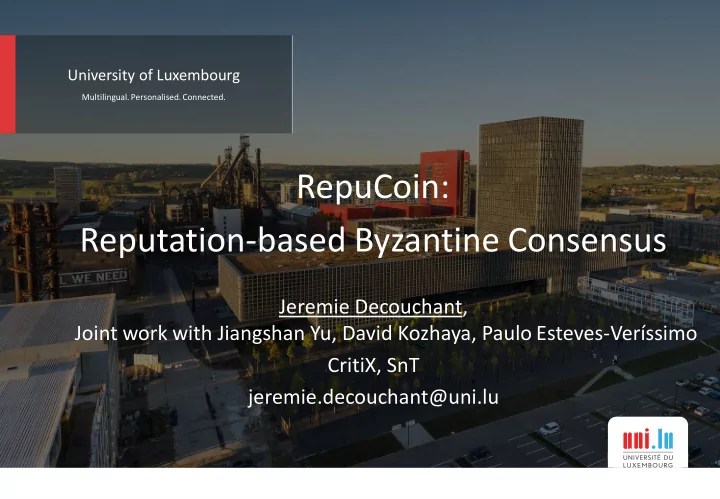

University of Luxembourg Multilingual. Personalised. Connected. RepuCoin: Reputation-based Byzantine Consensus Jeremie Decouchant, Joint work with Jiangshan Yu, David Kozhaya, Paulo Esteves-Veríssimo CritiX, SnT jeremie.decouchant@uni.lu
RepuCoin: addressing the 51% attack RepuCoin: Reputation-Based Byzantine Consensus 2
RepuCoin: addressing the 51% attack RepuCoin: Reputation-Based Byzantine Consensus 3
RepuCoin – Intuition 1. Miners gain reputation by contributing to the blockchain 2. Only top reputed miners can vote through a BFT protocol (e.g., PBFT) 3. Mis-behaved miners will be punished, and they lose reputation 4. Leaders are randomly selected from top reputed miners to propose transactions RepuCoin: Reputation-Based Byzantine Consensus 4
RepuCoin – Increased attack resilience • For an adversary to build enough reputation takes time Breaking the liveness property: RepuCoin: Reputation-Based Byzantine Consensus 5
RepuCoin – Increased attack resilience • For an adversary to build enough reputation takes time Breaking the liveness property: RepuCoin: Reputation-Based Byzantine Consensus 6
Implementation: BFT-SMaRt (Java) https://github.com/bft-smart/library The block is added to the blockchain A block was discovered in the network Block ordering RepuCoin: Reputation-Based Byzantine Consensus 7
Implementation: BFT-SMaRt (Java) https://github.com/bft-smart/library 3f+1 Miners Consensus reached when: - 2f+1 miners agree on a block - They represent more than two 3rd of the group reputation RepuCoin: Reputation-Based Byzantine Consensus 8
Performance evaluation Measure • Latency • Throughput Depending on • Consensus group size • Block size Settings (in the code) • Limit bandwidth • Impose network latency RepuCoin: Reputation-Based Byzantine Consensus 9
HPC workflow 1. Find a set of machines on a single cluster 2. Create an interactive job and connect to it $ oarsub – I – l nodes=13,walltime=1:0:0 $ oarsub – C 12345 3. Edit BFT- SMaRt’s config files (machines to use and port) $ cat $OAR_NODEFILE 4. Bash: script to run the throughput/latency benchmark – Kill any java application on the machines – Launch replicas – Launch clients $ oarsh –f ${ip_addr} ‘‘cd bftsmart.repucoin; ./runscript > /dev/null 2>&1 &’’ & 5. Python: collect the results (output file) and plot RepuCoin: Reputation-Based Byzantine Consensus 10
Best practices • Search for the right code basis – Your life will be much easier • Automate everything – You always think you won’t need to repeat the experiments: wrong! – The initial additional work is quickly amortized • Latency vs. throughput experiments are tricky – The throughput should increase with the load up to a certain point, where the latency starts increasing – But too many requests make the applications crash (message queues) – Find the right number of clients RepuCoin: Reputation-Based Byzantine Consensus 11
Lessons learned • Estimate the time it takes for your experiment and double it – Plan ahead • It is difficult to be on a completely controlled environment – Change the machines Change your performance – Are there a lot of jobs ongoing? • Performance is sometimes difficult to understand – Example: The performance with 8MB blocks is lower than with 4MB – I spent a day repeating the experiments and got the same result: I still don’t explain it RepuCoin: Reputation-Based Byzantine Consensus 12
Recommend
More recommend